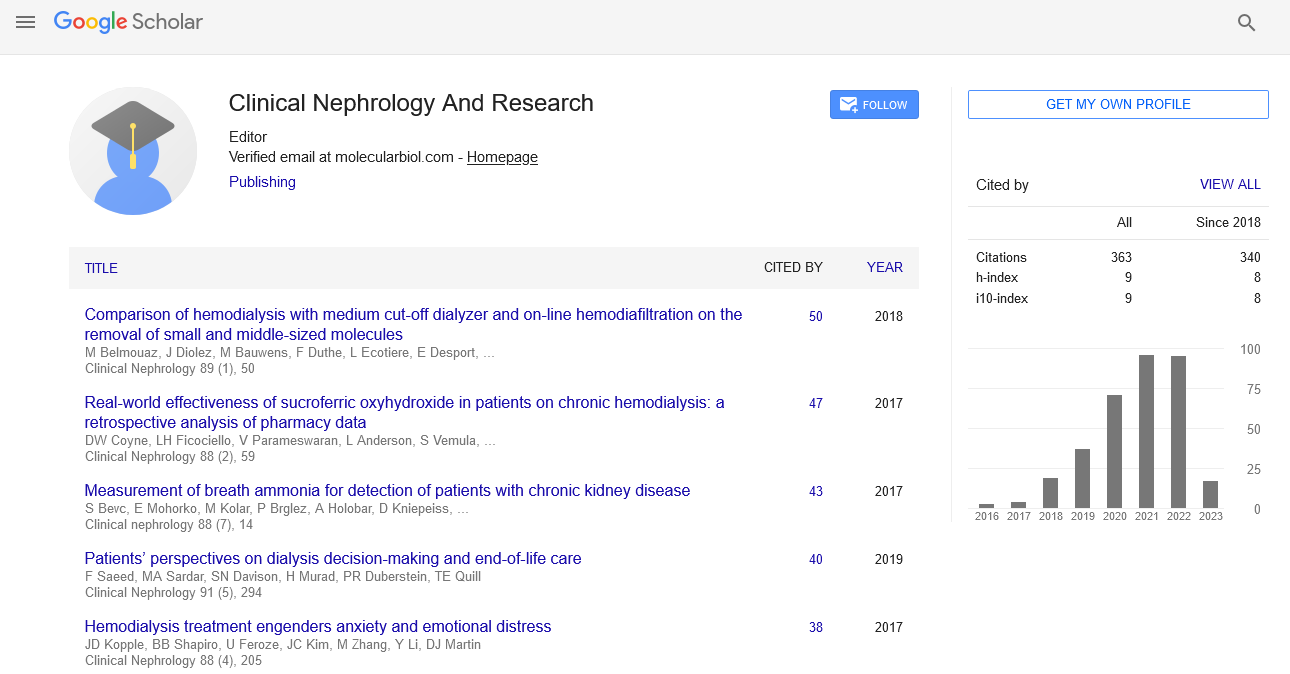Organoids of the kidney as a possible nephrology tool
Received: 10-Jan-2022, Manuscript No. PULCNR-22-4104; Editor assigned: 12-Jan-2022, Pre QC No. PULCNR-22-4104(PQ); Reviewed: 16-Apr-2022 QC No. PULCNR-22-4104(Q); Revised: 17-Jan-2022, Manuscript No. PULCNR-22-4104(R); Published: 27-Jan-2022, DOI: 10.37532/pulcnr.22.6.(1).3-4
Citation: Garcia B. Organoids of the kidney as a possible nephrology tool. Clin Nephrol Res.2022;6(1):3-4.
This open-access article is distributed under the terms of the Creative Commons Attribution Non-Commercial License (CC BY-NC) (http://creativecommons.org/licenses/by-nc/4.0/), which permits reuse, distribution and reproduction of the article, provided that the original work is properly cited and the reuse is restricted to noncommercial purposes. For commercial reuse, contact reprints@pulsus.com
Abstract
Kidney disease has become a worldwide public health issue, affecting over 750 million people and putting a significant financial strain on individuals. The human kidney's complicated architecture makes studying the pathogenesis of renal disorders in vitro and developing viable therapy choices for patients extremely difficult. Despite the fact that cell lines and animal models have improved our understanding, they still fail to capture crucial elements of human kidney development and illness at the molecular and functional levels. Organoids can be made from pluripotent stem cells or adult stem cells by carefully controlling signalling pathways. These self-differentiated organoids are now a promising technique for a new level of understanding of the human kidney, one of the most complex organs. Kidney organoids will be pushed to the next generation by newly established techniques improved by organ-on-chip and coculture with immune cells. We describe current advances in the use of kidney organoids in disease modelling, nephrotoxic testing, precision medicine, biobanking, and regenerative therapy, as well as creative ways for increasing their utility in biomedical research. The applications we present may aid in the development of novel clinical concepts.
Key Words
Disease modelling; Kidney organoids; Precision medicine; Stem cells; Biomedical research
Introduction
The human kidney is a complicated organ with around one million nephrons. The nephron is the kidney's functional unit, with a renal corpuscle for filtering and a renal tubule for reabsorption. Any change in the nephron's structure can have a significant impact on the kidney's function. The study of kidney organogenesis is slowed by the fact that there are so many different cell types and so much architectural intricacy. In addition, the human kidney regulates acidbase balance, electrolyte concentrations, extracellular fluid volume, and blood pressure to maintain whole-body homeostasis [1]. Kidney disease can be caused by hereditary diseases, but it can also develop as a result of chronic ailments such inflammatory illness, high blood pressure, or diabetes [2]. The kidney is particularly sensitive to druginduced renal impairment since it is a main target organ for toxic side effects [3]. Biological investigations in nephrology currently rely primarily on two-Dimensional (2D) cell lines. Cell lines, on the other hand, lack a variety of cell types and cell-scaffold interactions. In a monolayer, cells have no support for vertical spreading, which might lead to aberrant polarity in select cells. The lack of oxygen, nutrients, and factors in traditional 2D culture media limits its ability to accurately reflect the in vivo environment. Effective models are desperately needed to better understand kidney disease. Organoids are three-dimensional (3D) cell aggregates generated in vitro that are selfrenewing and self-organizing, and they have organ functions similar to the tissue of origin. Adult Stem Cells (ASCs) and induced Pluripotent Stem Cells (iPSCs) can both be used to make them. Aside from the multicellular structures known as organoids, the organoids culture system also comprises a variety of growth agents chosen for their role(s) in kidney development. The Extracellular Matrix (ECM), which not only provides mechanical support for organoids but also contributes in cell growth, migration, differentiation, and survival is also required for cell differentiation and orientation [4]. Several organoids have been created in recent years to represent organs produced from various germlines. Organoids have been used to research a variety of diseases, particularly monogenic genetic diseases. Furthermore, tumour organoids are proving to be an effective tool for elucidating the mechanisms of cancer genesis and progression. Organoids have recently been used by some researchers to explore the complex tumour microenvironment. Organoids of the kidney offer a fresh way to investigate nephrology. The application of renal organoids in the fields of kidney development and disease, drug testing, and precision medicine will be the focus of this review. We'll also discuss the benefits and drawbacks of new technologies that have emerged in the last five years, such as single-cell RNA sequencing and microfluidic devices.
Bibliometric analysis of kidney organoids research
Again, kidney organoids played a key part in disease modelling, as researchers looked for new and effective ways to unravel disease pathophysiology and advance precision treatment. With the advancement of 3D organoids, particularly in kidney medicine, in recent years, researchers in and outside the country have produced a slew of theses delving further into the etiology, pathophysiology, application, and other aspects of the subject. We used Bibliometric analysis to sift and summarise the published papers in order to make this review more systematic and complete.
Getting to the bottom of kidney organogenesis
The organoid model has a lot of potential uses in the field of kidney development. Animal models have largely been used to study kidney organogenesis up to now. Despite the fact that the mouse model has improved our understanding of human development, the basic distinctions between humans and animals have hampered further research [5]. Organoids are easier to genetically modify than animal models and enable for more accurate investigation of developmental illnesses. Despite the fact that the human embryo is the greatest material, most countries prohibit such work on the embryo as a molecular and cellular model due to ethical concerns. Organoids, as a new technology, are thus becoming a game-changing tool for developmental research [6]. Multiple procedures using Human Induced Pluripotent Stem Cell-Derived (hiPSC-derived) kidney organoids have been developed in recent years to mimic kidney development in vivo. To stimulate in vitro renal lineage development, a mixture of small compounds is introduced to culture systems. Takasato and coworkers described a multi-step procedure for growing 3D kidney organoids from iPSCs. These findings add significantly to our knowledge of renal embryogenesis. Podocyte maturation is been studied using hiPSC-derived kidney organoids. To compare the transcriptional patterns of podocytes from human fetal kidney with organoid-generated podocytes, scRNA-Seq was used to assess podocyte development. Organoid-generated podocytes had remarkably comparable, progressive transcriptional patterns despite the lack of vasculature. Another area where it could be used is in the study of selforganization. Cellular self-organization occurs when a cell's behaviour changes as a result of its interactions with other cells. In such densely coupled networks, feedback loops are more common than linear paths for information flow [7]. As a result, tissue-level phenomena are thought to occur as a result of this intrinsic non-linearity. The complicated temporal and unique link between the ureteric bud and the metanephric mesenchyme, where self-organization plays a key role, is known as kidney organogenesis. Deciphering the underlying mechanisms is difficult due to technological limitations. However, advances in organoids have opened up new avenues for research in this subject. Taguchi et al. developed a method for reassembling higherorder organ structures, which can be utilized to mimic embryonic branching morphogenesis [8]. They incorporated the branching epithelium into an organoid as a tissue geometry organizer and confirmed that the branching epithelium is required for organ expansion as a progenitor niche. Their reassembly technology, when combined with kidney organoids, will be a potent tool for recapturing organotypic architecture.
Overall, organoids derived from iPSCs will be a great tool for gaining insights into kidney development because they can circumvent ethical difficulties to some extent. Continuous organoid optimization could lead to even more advancements in developmental research.
Disease simulation
Several effective attempts to use kidney organoids as a novel diseasemodeling platform have recently been reported in studies. Organoids produced from iPSCs or adult kidney tubular epithelium are genetically heterogeneous and match the complex in vivo environment better than lineage-restricted cell lines. The availability of numerous cell types allows researchers to analyse the disease microenvironment in vitro. Furthermore, the organoids' 3D cell cultures represent a key step in a trend toward more physiologically appropriate tissue models. In the case of glomeruli, 3D organoid-derived glomeruli had higher gene expression linked with slit diaphragm components, renal filtration cell differentiation, and glomerular growth than 2D cultures.
Organoids generated from PSCs
Organoids made from PSCs are made through a combination of guided differentiation, morphogenetic processes, and intrinsically driven cell self-assembly. They have the ability to construct structures through mechanisms that occur solely during embryonic development, giving them an advantage in the modelling of genetic diseases. The kidney is a very complicated organ with a wide spectrum of disorders, many of which are genetically based. End-Stage Renal Disease (ESRD) can be caused by genetic diseases of renal structure and function, for which therapies are restricted in availability and efficacy. Autosomal Dominant Polycystic Kidney Disease (ADPKD), which affects approximately 12.5 million people globally, is one of the most wellknown monogenic renal illnesses. It's defined by aberrant cell development and growth. More than 90% of ADPKD cases are caused by mutations in the PKD gene, which codes for the polycystin protein, which is mostly produced in the primary cilium. The role of these alterations in the early phases, however, has yet to be determined. Using a combination of iPSC-derived kidney cells and CRISPR/Cas9 gene editing, Freeman et al were the first to produce renal-like structures in vitro and mimic a PKD-relevant phenotype [9]. CRISPR/Cas9 gene editing was used to create renal organoids from PKD-iPSCs with biallelic, truncating mutations in PKD1 or PKD2. Large, translucent cyst-like formations were discovered beside kidney organoids in PKD hPSCs several weeks later, which were not present in unaffected controls. The first PKD cysts appeared at around 35 days and continued to grow for the length of the culture. These studies proved that PKD mutations cause aberrant cystogenesis on their own. Polycystins may usually work to positively regulate actomyosin activation within the tubular epithelium, strengthening and tightening the tubule to avoid the formation of a cyst, according to highthroughput screening of this gene-edited model [10]. The findings helped to shed light on the molecular activities of polycystin proteins in ADPKD.
Unlike ADPKD, where genetic changes may easily be seen in living patients, the incidence of PODXL mutations in podocytopathies is relatively low because to the illness's embryonic or perinatal mortality, making research on the role of PODXL variants in disease more challenging.
REFERENCES
- Nyengaard JR, Bendtsen TF. Glomerular number and size in relation to age, kidney weight, and body surface in normal man. Anat Rec. 1992;232(2):194-201.
- Levey AS, Coresh J. Chronic kidney disease. Lancet. 2012;379(9811):165-180.
- Kim SY, Moon A. Drug-induced nephrotoxicity and its biomarkers. Biomol Ther. 2012;20(3):268.
- Baker BM, Chen CS. Deconstructing the third dimension-how 3D culture microenvironments alter cellular cues. J Cell Sci. 2012;125(13):3015-3024.
- Shanks N, Greek R, Greek J. Are animal models predictive for humans? Philos Ethics Humanit Med. 2009;4(1):1-20.
- Bredenoord AL, Clevers H, Knoblich JA. Human tissues in a dish: The research and ethical implications of organoid technology. Science. 2017;355(6322).
- Werner S, Vu HT, Rink JC. Self-organization in development, regeneration and organoids. Curr Opin Cell Biol. 2017;44:102-109.
- Taguchi A, Nishinakamura R. Higher-order kidney organogenesis from pluripotent stem cells. Cell Stem Cell. 2017;21(6):730-746.
- Freedman BS, Brooks CR, Lam AQ, et al. Modelling kidney disease with CRISPR-mutant kidney organoids derived from human pluripotent epiblast spheroids. Nat Commun. 2015;6(1):1-3.
- Czerniecki SM, Cruz NM, Harder JL et al. High-throughout screening enhances kidney organoid differentiation from human pluripotent stem cells and enables automated multidimensional phenotyping. Cell Stem Cell. 2018;22(6):929-940.





